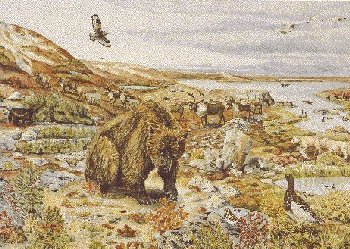When the first European visitors confronted Canada's Arctic they called it the Barren-lands. Forming the southern fringe of this massive ecosystem, the Southern Arctic ecozone may indeed seem barren when viewed from a distance. This is a place where nature's abundance and diversity are subdued by the harsh climate and terrain. But look closely at this landscape during the sudden greening of spring, the endless days of summer, or the brief blush of fall, and you will discover a land of plenty.
For almost a million square kilometres, the pattern of habitats in the Southern Arctic is the same: sprawling shrublands, wet sedge meadows, and cold, clear lakes. Superimposed on this pattern are the fascinating shapes and textures created by intense frost action in the soil.
The Northwest Territories portion of the Southern Arctic Ecozone is home to the world's biggest concentration of free-roaming large mammals. These are Barren-ground Caribou, the so-called "Buffalo of the Tundra." They began their annual migration cycle through this area soon after the last ice age ended. Evidence of that age is still plainly visible in the glacial etchings and deposits found throughout the region.
For thousands of years, abundant large mammals lured hunters from both sides of the treeline. The Dene and Inuit used its great rivers -- the Thelon, Back, and Coppermine -- to reach Caribou, Muskox, and Moose. They came most often in the fall to secure the large supplies of meat necessary to carry them through the winter. Though floatplanes are now the main mode of access, the rivers are still used by people from all walks of life to enjoy the beauty and bounty of the frontier.
